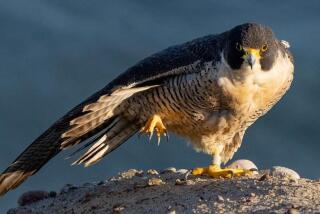ENVIRONMENT : Eagles Flock to an Unlikely Feast : In an ironic twist, a much-maligned dam creates a trout spawning ground that attracts the endangered birds.
- Share via
TUBA CITY, Ariz. — Longtime Colorado River guide Teresa Yates sensed something strange when she noticed five bald eagles at the mouth of Nankoweap Creek in the Grand Canyon.
It was 1987 on a late winter river trip. It was unusual for the big birds to be there because they’re not native to the canyon. Torn pieces of dead trout strewn along the banks of the little creek offered a clue to their presence.
Yates told eagle expert Bryan Brown of her find. At first he noticed six to 10 eagles at Nankoweap. In 1988, he documented 18 birds.
A year ago, the first year of a federally sponsored study, he looked on stunned as 26 huge, white-headed raptors engaged in a feeding frenzy on the rainbow trout using the tributary tospawn.
“It’s just off the scale of amazingness,” Brown says.
What’s happening here is indeed incongruous and unique. The remote and hard to reach Nankoweap district of the Grand Canyon is best known to river runners for its tricky rapids, towering rocky cliffs and small, thousand-year-old Anasazi Indian ruins built high into the canyon’s sheer, red sandstone wall.
Suddenly arriving onto this already dramatic scene are dozens of bald eagles, with possibly half of those wintering in the state coming here, says Brown, who has studied eagles throughout Arizona and northern Mexico.
Like the songbirds that have increased a thousandfold along the river corridor, eagles are now using an area they once rarely frequented.
Clearly, researchers agree, they are here because of the spawning trout, and the trout are here because of the much-maligned, 27-year-old Glen Canyon Dam.
Not only is this an environmental irony, but the appearance of this particular endangered species heralds yet another philosophical question for the half dozen agencies now trying to figure out how best to manage the controversial dam, the Colorado River and the Grand Canyon National Park.
Brown’s study of the eagles is just one of about 40 research projects designed to determine what effect the dam’s current operation is having on the Grand Canyon ecosystem.
Since the dam’s completion in 1963, environmentalists have decried the loss of the enchanted Glen Canyon, now sunk in a watery grave beneath Lake Powell in northern Arizona. They’ve also fiercely criticized the dam’s impact on the Colorado River downstream. Overnight the river changed from wild, warm and muddy to controlled, cold and clear. Periodic floods that used to scour the river’s banks clean of vegetation, while redepositing billions of tons of sediment, were ended.
While the natural aquatic conditions of the Colorado were destroyed, entirely new riparian and aquatic habitats were created. Rainbow trout were introduced at Lees Ferry and the river has become an unsurpassed fishery where trout easily grow to 20 inches or more.
The rainbows spread throughout 200 miles of river in the Grand Canyon. The most productive section remains the 76 miles between the dam and the still wild Little Colorado. And the best of this is at Nankoweap.
Besides the river itself, the five-foot wide, foot-deep creek is the only tributary trout can reproduce in for more than 100 miles. In recent years, the spawn has become so intense, fish often seem as crowded in the water as words on a printed page.
“Some of these fish are so big and the creek is so shallow that they’re not even totally submerged,” says fish biologist Bill Leibfried.
Sometime in the past 10 years, says Brown, eagles discovered what’s now become the most important stop along their ancient migratory flyway.
“It’s like this incredible coincidence of geography and ecology that put the trout spawn right there,” he says. “Even if they weren’t aware of Nankoweap, as they’re migrating north they would automatically bump into it, see the other eagles there, see the fish, or both.”
Within a week’s time of grabbing fish, sometimes in both talons at once, and eating six or seven a day, the eagles are primed for their return north.
While both the trout spawn and the eagle population were lower this year--the peak eagle congregation was counted as 13--Brown sees the area as a key to the future survival of the birds.
“That’s the take-home message for the park service,” he adds. “. . . We should manage the river carefully and take care of the trout spawn even though it is all man-made. It really benefits things.”
More to Read
Sign up for Essential California
The most important California stories and recommendations in your inbox every morning.
You may occasionally receive promotional content from the Los Angeles Times.










